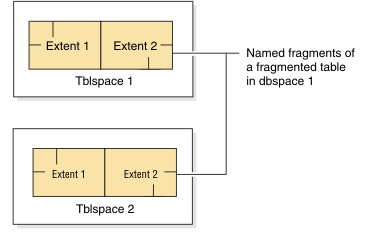Structure of Fragmented Tables
Although table fragmentation is transparent to applications, as database server administrator you should be aware of how the database server allocates disk space for table fragments and how the database server identifies rows in those fragments.
Each table fragment has its own tblspace with
a unique tblspace_id or fragment_id. Figure 1 shows the disk allocation
for a fragmented table that resides in named fragments of the same
dbspace.
Figure 1. Disk
Structures for a Fragmented Table

Attached Indexes
With an attached index, the index and data are fragmented in the same way. You can decide whether to store the index pages with the corresponding data pages in the same dbspace or store them in separate dbspaces. For information on choosing a fragmentation strategy, see the IBM® Informix® Performance Guide.
Detached Indexes
For detached indexes, the table fragment and index fragment are stored in tblspaces in separate dbspaces.